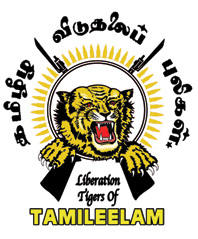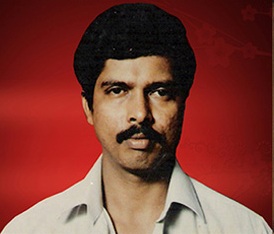Related Research Articles

The Liberation Tigers of Tamil Eelam was a Tamil militant organization, that was based in the northern and eastern Sri Lanka. The LTTE fought to create an independent Tamil state called Tamil Eelam in the northeast of the island in response to violent persecution and discriminatory policies against Sri Lankan Tamils by the Sinhalese-dominated Sri Lankan Government.

Velupillai Prabhakaran was a Sri Lankan revolutionary. Prabhakaran was a major figure of Tamil nationalism, and the founder and leader of the Liberation Tigers of Tamil Eelam (LTTE). The LTTE was a militant organization that sought to create an independent Tamil state in the north and east of Sri Lanka in reaction to the oppression of the country's Tamil population by the Sri Lankan government. Under his direction, the LTTE undertook a military campaign against the Sri Lankan government for more than 25 years.

Maaveerar Naal is a remembrance day observed by Sri Lankan Tamils to remember the deaths of militants who fought with the Liberation Tigers of Tamil Eelam (LTTE) to achieve an independent Tamil homeland. It is held each year on 27 November, the date on which the first LTTE cadre, Lt. Shankar, died in combat in 1982. Traditionally oil lamps are lit for the three days ending on 27 November and the Tamil Eelam flag is raised at ceremonies. The symbol for Maaveerar Naal is the Gloriosa superba which blooms during November.
Sri Lankan Tamil militant groups rose to prominence in the 1970s to fight the state of Sri Lanka in order to create an independent Tamil Eelam in the north of Sri Lanka. They rose in response to the perception among minority Sri Lankan Tamils that the state was preferring the majority Sinhalese for educational opportunities and government jobs. By the end of 1987, the militants had fought not only the Sri Lankan security forces but also the Indian Peace Keeping Force. They also fought among each other briefly, with the main Liberation Tigers of Tamil Eelam (LTTE) rebel group dominating the others. The militants represented inter-generational tensions, as well as the caste and ideological differences. Except for the LTTE, many of the remaining organizations have morphed into minor political parties within the Tamil National Alliance, or as standalone political parties. Some Tamil militant groups also functioned as paramilitaries within the Sri Lankan military against separatist militants.

TamilNet is an online newspaper that provides news and feature articles on current affairs in Sri Lanka, specifically related to the erstwhile Sri Lankan Civil War. The website was formed by members of the Sri Lankan Tamil community residing in the United States and publishes articles in English, German and French.

Hinduism is a minority religion practised by 0.6% of the population of Switzerland. Approximately 90% of Hindu adherents are foreign-born, and about a third of them have the status of refugee or asylum seeker. The Sri Sivasubramaniar Temple, located in the Sihl Valley in Adliswil, is the most famous and oldest Hindu temple in Switzerland, the Arulmihu Sivan Temple located in Glattbrugg is dedicated to Shiva, and the latest foundation is the Sri Vishnu Thurkkai Amman Temple in Dürnten in 2010.

Tamil Eelam is a proposed independent state that many Tamils in Sri Lanka and the Eelam Tamil diaspora aspire to create in the north and east of Sri Lanka. Large sections of the North-East were under de facto control of the Liberation Tigers of Tamil Eelam (LTTE) for most of the 1990s–2000s during the Sri Lankan Civil War. Tamil Eelam, although encompassing the traditional homelands of Eelam Tamils, does not have official status or recognition by world states. The name is derived from the ancient Tamil name for Sri Lanka, Eelam.
The University Teachers for Human Rights (Jaffna) or UTHR(J) was formed in 1988 at the University of Jaffna, Jaffna, in Sri Lanka, as part of the national organization University Teachers for Human Rights. Its public activities as a constituent part of university life came to a standstill after the assassination on September 21, 1989 of Rajini Thiranagama, a key founding member, for which the group blamed the LTTE.
The Anuradhapura massacre occurred in Sri Lanka in 1985 and was carried out by the Liberation Tigers of Tamil Eelam. This was the largest massacre of Sinhalese civilians by the LTTE to date; it was also the first major operation carried out by the LTTE outside a Tamil majority area. Initially, EROS claimed responsibility for the massacre, but it later retracted the statement, and joined the PLOTE in denouncing the incident. The groups later accused the LTTE for the attack. Since then, no Tamil militant group has admitted to committing the massacre. However, state intelligence discovered that the operation was ordered by the LTTE's leader Velupillai Prabhakaran. He assigned the massacre to the LTTE Mannar commander Victor and it was executed by Victor's subordinate Anthony Kaththiar. The LTTE claimed the attack was in revenge of the 1985 Valvettiturai massacre, where the Sri Lanka Army killed 70 Tamil civilians in Prabhakaran's hometown. In 1988, the LTTE claimed that the massacre was planned and executed under the guidance of Indian intelligence agency, RAW.

Charles Lucas Anthony was a Sri Lankan Tamil rebel and leading member of the Liberation Tigers of Tamil Eelam (LTTE), a separatist Tamil militant organisation in Sri Lanka.
Perinpanayagam Sivaparan is a Sri Lankan Tamil rebel and leading member of the Liberation Tigers of Tamil Eelam (LTTE), a separatist Tamil militant organisation in Sri Lanka.

Visuvanathan Rudrakumaran is the prime minister of the Transnational Government of Tamil Eelam, which aims to realize accountability for crimes against humanity, war crimes and genocide committed by Sri Lanka against the Tamil minority and to create a separate Tamil state, called Tamil Eelam in Sri Lanka. He was the former legal advisor to the Liberation Tigers of Tamil Eelam (LTTE). By profession he is a lawyer in the United States. He is currently a US citizen and lives in New York City.

The Transnational Government of Tamil Eelam (TGTE) is a transnational organisation among the Sri Lankan Tamil diaspora which aims to establish Tamil Eelam, a secular and democratic socialist state which many Tamils aimed to create in the North-East of Sri Lanka.
Divisions of the Liberation Tigers of Tamil Eelam refers to the military, intelligence and overseas divisions the Liberation Tigers of Tamil Eelam (LTTE). Most of these divisions were destroyed during the Eelam War IV, and only parts of the intelligence and financing divisions remain overseas.
The Liberation Tigers of Tamil Eelam (LTTE), a separatist militant organization formerly based in northern Sri Lanka, had various organizations affiliated to it. These include charitable organizations, political parties, state intelligence organizations and even governments of Sri Lanka and other countries. Although the LTTE was militarily defeated in 2009, the Sri Lankan government alleges that a number of foreign-based organizations are still promoting its ideology.

Sundaram Sri Sabaratnam was a Sri Lankan Tamil rebel and leader of the Tamil Eelam Liberation Organization (TELO), a separatist Tamil militant organisation in Sri Lanka.

The Sri Vishnu Thurkkai Amman Temple is a Hindu temple located in the municipality of Dürnten in the canton of Zürich in Switzerland.

Swiss Tamils refer to the Swiss citizens of Tamil as well as expatriate residents of Tamil origin living in Switzerland. Most of the Tamils in Switzerland are from Sri Lanka, who came to Switzerland during 1980s and 1990s as refugees due to the Sri Lankan Civil War. The Tamils are well integrated in the Swiss society and have proved themselves as a hard-working people and many young Tamils are doing well in school. Tamil values are still strong among the community, social system and arranged wedding are common. The second generation seem to be better integrated than the first generation, but most still follow the old ways.
There are allegations of various types of criminal activities levelled against the Liberation Tigers of Tamil Eelam (LTTE) by state actors and agencies.
References
- ↑ A Welcome by the Ambassador. Eda.admin.ch (2010-09-27). Retrieved on 2011-06-12.
- ↑ Sri Lankan Diaspora – Switzerland Archived 2010-12-10 at the Wayback Machine . Srilankandiaspora.ch. Retrieved on 2011-06-12.
- 1 2 Social Change Among Sri Lankan Tamil Refugees in Switzerland Archived 2011-07-06 at the Wayback Machine . Forschungsportal.ch. Retrieved on 2011-06-12.
- 1 2 3 Sri Lanka Perspectives – January 2011. Sri Lanka Guardian. Retrieved on 2011-06-12.
- 1 2 3 Ramifications of crackdown on LTTE in Switzerland | Lanka Magazine Archived 2011-07-13 at the Wayback Machine . Lankamagazine.com (2011-01-29). Retrieved on 2011-06-12.
- ↑ Onlanka News – Tamil Diaspora in Switzerland squeezed for money by LTTE «. Onlanka.com (2011-01-25). Retrieved on 2011-06-12.
- ↑ Internet Archive WayBack Machine
- ↑ Annette Saloma-Huber (2012-07-23). "Tamilen schlossen Tempelfest mit Wasserritual ab" (in German). Zürcher Oberländer . Retrieved 2014-12-18.
- ↑ Regula Lienin (2013-07-20). "Ein Pfauentanz für Göttin Amman" (in German). Zürcher Oberländer . Retrieved 2014-12-25.
- ↑ Hannah Einhaus (2012-07-12). "Grosser Brocken für die kleinen Gemeinschaften im Haus der Religione". Berner Zeitung (in German). Berner Zeitung BZ. Retrieved 2014-12-25.
- ↑ "Weltweit einziges "Haus der Religionen" eröffnet: Das international einmalige Haus der Religionen öffnete am Sonntag seine Pforten. Acht Religionsgemeinschaften sollen unter einem Dach zusammen leben". 20 Minuten (in German). 2014-12-14. Retrieved 2014-12-25.
- ↑ Michael Meier (2014-12-23). "Sie wollen uns den Glauben zurückbringen". Tages-Anzeiger (in German). Retrieved 2014-12-25.
- ↑ Matthias Scharrer (2014-11-14). "Dinah Hess: "Alle haben ihre Eigenarten –aber alles gehört zusammen"". Limmattaler Zeitung (in German). Retrieved 2014-12-25.
